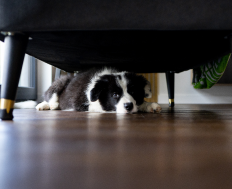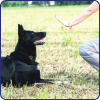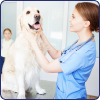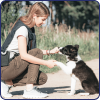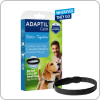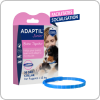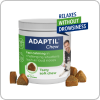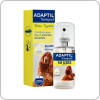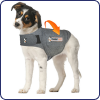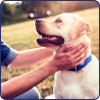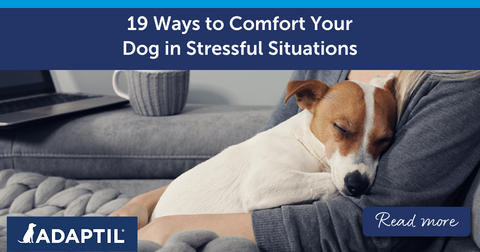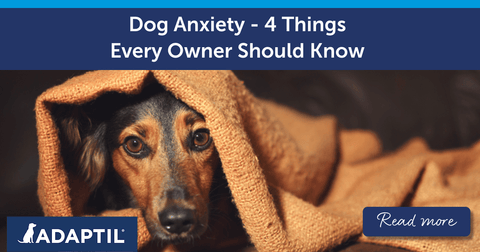
Happy Dog Expert: Canine Chronicles Part 1 – Puppy Development
Our dogs’ lives are made up of several developmental stages. In each of these stages, there are experiences – both positive and negative – that affect how they respond to stress. These experiences can lead to greater tolerance or, in some cases, more anxiety and fear. This is especially important during the early puppy development stages, when positive exposure and support are key.
Let’s explore these puppy life stages together, as well as the potential risk factors and how we can help our pets find their happy ending along the way. We will divide our lifespan story into a beginning, middle, and end, and discuss how each stage may lead to some mental health challenges.
This article is the first in a series of three, chronicling our dogs’ lives from beginning to end, and how we can support their mental health at each stage.
By Amy Learn, Behaviour Veterinarian - Chief of Staff of Clinical Behavioural Medicine at the animal behaviour wellness Center in Richmond, Virginia
Before Birth & Puppyhood
“Once upon a time” is a great way to start a chronicle of a canine’s life, but things start even before that...
Genetics & Breed Tendencies
One area to consider when exploring a puppy’s development stages is the difference between genetics and breeds. There are approximately 400 recognised dog breeds in the world right now. And aside from size and morphological differences, there may be cognitive and behavioural differences as well.
Examples of the differences between breeds include:
-
Some breeds are severely inbred, and some breeds have field-trial or show line subsets. All of this can cause further behavioural variations, even among the same breeds. Researchers have even found that standard traits like shyness or boldness can be heritable.
-
A few breeds of dog are little changed in look and behavior from wolves, such as Huskies. Others are completely different, such as French Bulldogs.
-
There have been certain breeding lines that were more aggressive than others within the same breed. An example of this is found in English Springer Spaniels and a condition once thought of as ‘springer rage’, which has since been bred out of the line.
Maternal Foetal Stress
Aside from the heritability of certain traits, the environment where the foetus grows is also an important factor in determining an individual’s behavioural tendencies.
During gestation, a dog’s body and brain develops rapidly, and this development stage is directly affected by chemicals and hormones circulating in the womb. Canine mothers that are malnourished, ill, or stressed have abnormal levels of stress-related chemicals, which can change a puppy’s brain structure and neural pathways. Consequently, the dam’s health, level of stress, nutrition, and environment can all affect the prenatal brain of the puppy.
Early Puppy Development Stages
The Impact of Malnutrition and Illness
After whelping, a new puppy will undergo many new experiences quickly. This stage in a puppy’s development can often be an overload of sensory information.
Some of this information is learned from the puppy’s canine family, and some from experiences they partake on their own. Either way, it all teaches the puppy about what is safe or not so that they can survive in the world.
During the first 13 weeks, the brain continues to change and grow and is very sensitive to external experiences. Specifically, in some suboptimal conditions such as malnutrition or trauma, the pathways may shift toward anxious or fearful tendencies.
Why a Puppy Socialisation Period Matters
Socialisation is also an important part of the cognitive and behavioural development stage of a puppy. From 3 -16 weeks, the brain is still forming neural pathways. During this period, a puppy needs to have a variety of experiences in which they feel safe and happy, as this will build resilience pathways.
Some pet parents may avoid social settings during this puppy stage. Or conversely, they may inadvertently flood or overwhelm their puppy with exposures, resulting in a less confident puppy. Both these situations should be avoided.
Monitoring a puppy’s body language can minimise these pitfalls. If there are signs of anxiety – for example, lip licking, wide eyes, a low or tucked tail, or trying to flee – then this may create a more fearful puppy, instead of a well-adjusted one.
There are several puppy-raising programs (e.g. Puppy Culture), which aim to teach breeders important scientific information about breeding their dogs. This ensures the best possible environment for puppy development, from conception to adoption, including this critical puppy socialisation period.
Choosing the Right Training Approach
There are many different types of dog trainers out there, but the field is largely unregulated. Important things to look for when considering an approach to early puppy training is whether they:
-
Include reward-based methods that encourage trust and autonomy.
-
Focus on teaching what to do, rather than punishment.
-
Avoid aversive methods – such as choke chains, prong collars, e-collars, or squirt bottles – and leash corrections or discussion of pack or dominance.
Training should be a fun experience for both dog and human. Importantly, puppies need not wait until paediatric vaccinations are completed to start training. Instead, they can start a class or work with a trainer as early as 8 weeks of age to take advantage of this critical time of brain development for puppies.
Supporting a Confident and Calm Dog
So, what can you do to provide the best chance for your puppy to be happy and healthy?
Before Adopting a Puppy
If possible, meet the puppy’s parents before adoption. A reputable breeder can provide information about any health or behaviour concerns in their lines. They should also allow you to interact with the parents and littermates, so you can get an overall picture of family dynamics.
When rehoming a dog, you may not have that ability, but you should still aim to get as much background information as possible about the dog. This includes things like how they behave in the shelter or foster home, why they were relinquished, and any other concerns the shelter has.
Bringing Your Puppy Home
When your puppy comes home, pay close attention to their body language for signs of stress or anxiety. Devote enough time to help your pup feel welcome and safe, and offer plenty of exercise and enrichment. Look for a class that uses positive-reinforcement and is geared for gentle exposure with lots of rewards.
Pheromones can help a puppy adjust to a new home, providing the same naturally comforting message their mother released. They can also help during scary events like storms and puppy classes. One great option to consider is ADAPTIL Junior: a collar that releases dog-appeasing pheromones to provide up to 30 days of comfort
When to Seek Professional Help
If your puppy seems more scared, restless, or aggressive than expected, seek help as soon as possible. Dogs will not grow out of a behaviour problem on their own, and if left, it is likely to get worse. Appropriate assistance from a veterinary behaviour professional will help fashion a treatment plan to aid your puppy’s developing behaviour.
Shaping a Happy Ending
A dog’s demeanour, general anxiety or fearfulness, and their ability to cope with stressful events can all result from many contributing factors. Some of these occur even before whelping, including genetics and maternal health or stress. Many others occur in the critical early development stages of puppyhood, when the brain is developing these behavioural tendencies at its fastest rate.
We may be able to investigate heritable traits from a breeding history before adoption. However, we also have a direct ability to guide socialisation and positive learning opportunities during early puppyhood. Puppy-raising programs, appropriate training methods, and veterinary behaviour professionals can aid us in this endeavor.
As much as we can do during these formative early ages, we should help to build the foundation of our dog’s adult behaviour tendencies. We will discuss this in our next chapter.
For more tips and advice on all things puppy care, why not check out our helpful range of articles online? Or to receive the latest news straight into your inbox, sign up for our newsletter and we’ll keep you updated with everything we’re up to!


